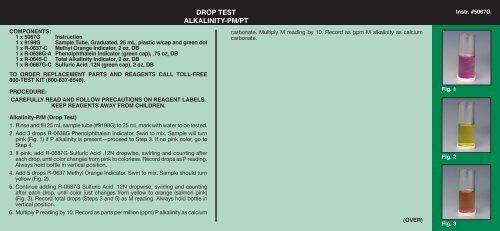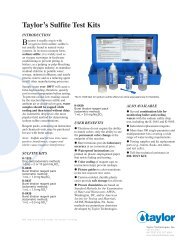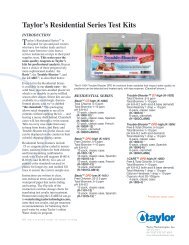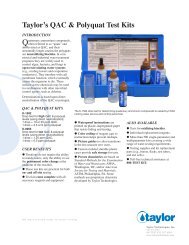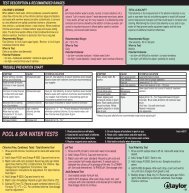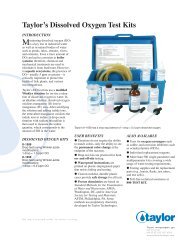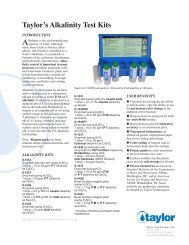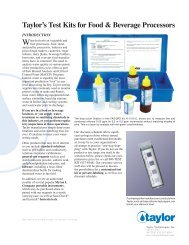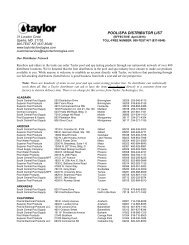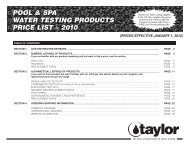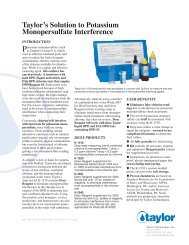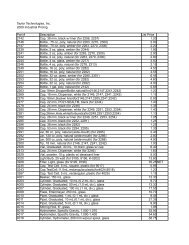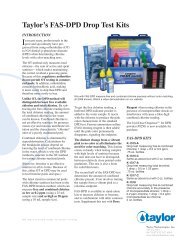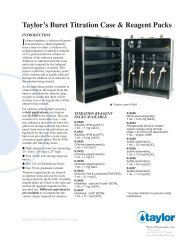5067G - Taylor Technologies
5067G - Taylor Technologies
5067G - Taylor Technologies
You also want an ePaper? Increase the reach of your titles
YUMPU automatically turns print PDFs into web optimized ePapers that Google loves.
COMPONENTS:<br />
1 x <strong>5067G</strong> Instruction<br />
1 x 9198G Sample Tube, Graduated, 25 mL, plastic w/cap and green dot<br />
1 x R-0637-C Methyl Orange Indicator, 2 oz, DB<br />
1 x R-0638G-A Phenolphthalein Indicator (green cap), .75 oz, DB<br />
1 x R-0645-C Total Alkalinity Indicator, 2 oz, DB<br />
1 x R-0687G-C Sulfuric Acid .12N (green cap), 2 oz, DB<br />
TO ORDER REPLACEMENT PARTS AND REAGENTS CALL TOLL-FREE<br />
800-TEST KIT (800-837-8548).<br />
PROCEDURE:<br />
CAREFULLY READ AND FOLLOW PRECAUTIONS ON REAGENT LABELS.<br />
KEEP REAGENTS AWAY FROM CHILDREN.<br />
DROP TEST<br />
ALKALINITY-PM/PT<br />
carbonate. Multiply M reading by 10. Record as ppm M alkalinity as calcium<br />
carbonate.<br />
Fig. 1<br />
Instr. #<strong>5067G</strong><br />
Alkalinity-P/M (Drop Test)<br />
1. Rinse and fill 25 mL sample tube (#9198G) to 25 mL mark with water to be tested.<br />
2. Add 3 drops R-0638G Phenolphthalein Indicator. Swirl to mix. Sample will turn<br />
pink (Fig. 1) if P alkalinity is present—proceed to Step 3. If no pink color, go to<br />
Step 4.<br />
3. If pink, add R-0687G Sulfuric Acid .12N dropwise, swirling and counting after<br />
each drop, until color changes from pink to colorless. Record drops as P reading.<br />
Always hold bottle in vertical position.<br />
4. Add 5 drops R-0637 Methyl Orange Indicator. Swirl to mix. Sample should turn<br />
yellow (Fig. 2).<br />
5. Continue adding R-0687G Sulfuric Acid .12N dropwise, swirling and counting<br />
after each drop, until color just changes from yellow to orange (salmon pink)<br />
(Fig. 3). Record total drops (Steps 3 and 5) as M reading. Always hold bottle in<br />
vertical position.<br />
6. Multiply P reading by 10. Record as parts per million (ppm) P alkalinity as calcium<br />
(OVER)<br />
Fig. 2<br />
Fig. 3
DROP TEST<br />
ALKALINITY-PM/PT<br />
1. Rinse and fill 25 mL sample tube (#9198G) to 25 mL mark with water to be tested.<br />
2. Add 3 drops R-0638G Phenolphthalein Indicator. Swirl to mix. Sample will turn<br />
pink (Fig. 4) if P alkalinity is present—proceed to Step 3. If no pink color, go to<br />
Step 4.<br />
3. If pink, add R-0687G Sulfuric Acid .12N dropwise, swirling and counting after<br />
each drop, until color just changes from pink to colorless. Record drops as P<br />
reading. Always hold bottle in vertical position.<br />
4. Add 5 drops R-0645 Total Alkalinity Indicator. Swirl to mix. Sample should turn<br />
green (Fig. 5).<br />
5. Continue adding R-0687G Sulfuric Acid .12N dropwise, swirling and counting<br />
after each drop, until color changes from green to red (Fig. 6). Record total drops<br />
(Steps 3 and 5) as T reading. Always hold bottle in vertical position.<br />
6. Multiply P reading by 10. Record as parts per million (ppm) P alkalinity as<br />
calcium carbonate. Multiply T reading by 10. Record as ppm T alkalinity as<br />
calcium carbonate.<br />
Fig. 4<br />
Fig. 5<br />
31 Loveton Circle, Sparks, MD 21152 U.S.A.<br />
800-TEST KIT (837-8548) • 410-472-4340 4/09<br />
Fig. 6


